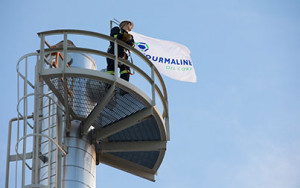2020's crude price crash offers a bright spot for natural gas producers

Veteran oilman Mike Rose says he doesn't want to “jinx it,'' but he admits it's not so bad heading the company that last year became the biggest producer of natural gas in Canada.
While many oil companies have curtailed production and chopped capital budgets to deal with a massive drop in demand for crude this year, Tourmaline Oil Corp. has been buying assets, running a fleet of 10 drilling rigs and reporting production at the high end of guidance.
“On the oil side, that's where the crisis was in March and April, and there was hue and cry from all governments and industry,'' said Rose, who has been CEO of Tourmaline since its founding in 2008.
“But the reality is we've had horrible gas prices for five years and it didn't seem to be as big a crisis. The gas producers that survived have figured out how to survive very low prices for extended periods of time. So that's partly why we're a little healthier.''
Natural gas has been considered by many as little more than an unprofitable byproduct for more than a decade, as the North American shale gas boom launched billions of cubic feet of the heating fuel on markets, driving down prices.
Gas economics got worse five years later when the technology was adapted to extract crude oil from tight underground shale formations in Canada and the United States, a technique that also freed more billions of cubic feet of associated natural gas.
When the twin crises of the Russia-Saudi price war and COVID-19 outbreak hit earlier this year, oil producers stopped drilling and shut down producing wells to avoid selling at a loss.
In turn, the sudden withdrawal of gas byproducts created a shortage, sending prices higher.
Futures contracts at the Alberta marketing hub for gas to be delivered next year have recently surged to a nearly four-year high of about $2.75 per thousand cubic feet -for comparison, Tourmaline's break-even price is about $1.75.
“In many ways, for the gas producers, what's bad for oil is good for gas,'' said Jordan McNiven, an analyst for Tudor Pickering Holt & Co.
A seasonal increase in gas demand this winter, combined with an expected recovery in global liquefied natural gas demand as economies recover from the pandemic, is expected to spur North American gas prices even higher, analysts say.
“We're constructive on the gas quote. We could see reasons why it could flex higher,'' said Robert Fitzmartyn, head of energy institutional research at Stifel FirstEnergy.
The rise of natural gas has been noticed at Canadian Natural Resources Ltd., the Calgary-based oilsands giant that was Canada's top gas producer before being dethroned last year.
In May, Canadian Natural announced it would reboot drilling on its long-ignored natural gas fields to add about 60 million cf/d to its long-standing output of around 1.4 billion cf/d.
Earlier this month, it doubled down on that interest by announcing a $461-million deal to buy Calgary rival Painted Pony Energy Ltd., which produces 270 million cf/d of natural gas in northeastern B.C.
“When we went into this year we thought prices would be a little more depressed,'' said Canadian Natural president Tim McKay in an interview after its second-quarter results were released last week.
“They've been quite strong and that gives us the opportunity to ramp up some volumes.''
The oil price crash is reflected in share prices. As of Tuesday, the only positive stock year-to-date of the 16 oil and gas producers on the S&P/TSX Capped Energy Index is Tourmaline, up 6.77% since Jan. 1.
The remainder have dropped between 20 and 70%, with ARC Resources Ltd., primarily a natural gas producer, down by the least amount with a 19.3% loss.
Last week, Tourmaline reported second-quarter production of more than 299,000 barrels of oil equivalent per day, up seven% over the same period last year, composed of 61,800 bpd of oil and liquids and 1.425 billion cubic feet of natural gas.
It reported its average gas price was up 16% but its average oil and liquids price fell by 41%.
Second-quarter cash flow -arrived at by subtracting operating and maintenance costs from revenue -came to $225 million, in line with $226 million in the same quarter of 2019. It expects $1.05 billion in cash flow this year on an $800-million capital budget.
The company aims to reach more than 322,000 boe/d by year-end after drilling 42 new wells in the third quarter and bringing on 57 more in the fourth. It estimates its 2020 average gas production will be 1.5 billion cf/d.
In April, Tourmaline completed the acquisition of Chinook Energy Inc. for $24.5 million and it bought several assets in northwestern Alberta for a total of $38.3 million.
Asked if there are more acquisitions to come, CEO Rose said, “Oh yeah. Potentially.''
He said Tourmaline's success hinges on strict control over costs, careful marketing to extract every possible penny from every cubic foot of gas and never getting too deep in debt.
On the latter front, he predicts the company will pay down enough debt to achieve an enviable debt-to-cash-flow ratio of 1:1 or lower sometime this year, if prices hold up.
“Fortunately, finally, we're looking at a pretty strong gas price recovery for 2021 and hopefully that extends into 2022,'' he said.
“It's looking a lot more positive on the natural gas side than it has for a while. But I don't want to jinx it.''
